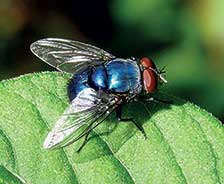Geetha Iyer
“What sort of insects do you rejoice in, where you come from?” the Gnat inquired.
“I don’t rejoice in insects at all,” Alice explained … Lewis Carroll, Through the Looking Glass
 Insects are not the best liked creatures, especially flies. Irritating pests is how we dismiss them and their close relatives, the gnats, midges, and mosquitoes. Which fly are we talking about by the way? Butterfly, dragonfly, stonefly, snakefly, sawfly, scorpionfly, firefly, mayfly or damselfly? No, not them as none of the insects listed above is a fly; they all have the suffix fly, perhaps a reference to their mode of locomotion. These pseudoflies are treated differently while true flies are dismissed as irritants or swatted! Swatting flies is sometimes a game with small children, much to the disapproval of adults!
Insects are not the best liked creatures, especially flies. Irritating pests is how we dismiss them and their close relatives, the gnats, midges, and mosquitoes. Which fly are we talking about by the way? Butterfly, dragonfly, stonefly, snakefly, sawfly, scorpionfly, firefly, mayfly or damselfly? No, not them as none of the insects listed above is a fly; they all have the suffix fly, perhaps a reference to their mode of locomotion. These pseudoflies are treated differently while true flies are dismissed as irritants or swatted! Swatting flies is sometimes a game with small children, much to the disapproval of adults!
Why, insects that are not true flies, have this synonym is an interesting exploratory activity that can be taken up in languages or sciences, but what you will read here is about true flies – insects that belong to the Order Diptera. ‘Diptera’ means two wings (Di-two, ptera-wings) and the characteristic feature of a true fly is this – unlike others from the insect world they possess only one pair of wings. Fly, mosquito, gnat and midges are other common insects of this Order Diptera. There are 1,52,244 species of Diptera to be found worldwide. They are the third largest group in the insect world, the first position going to Coleoptera (beetles and weevils) and the second to Lepidoptera (moths and butterflies).
Housefly is the most common representative of true flies. But you will be amazed to know that there are some stunningly beautiful representatives observable in the world of Diptera. While there are a number of flies that bite and carry diseases, there are several that are very useful, not worthy of disdainful dismissals!
The author is a consultant for science and environment education. She can be reached at scopsowl@gmail.com.
